5 Best AMD Motherboards In 2024
Are you ready to supercharge your gaming setup? Look no further than the best AMD motherboards on the market! These powerful components are the backbone of your PC, providing stability and performance for all your gaming needs. Get ready to level up your gaming experience with these top-notch motherboards!
5 Best AMD Motherboards In 2024
| Serial No. | Product Name | Check Price |
| 1. | ASUS ROG Strix X570-E Gaming | Check Price |
| 2. | MSI MPG X570 Gaming Plus | Check Price |
| 3. | Gigabyte X570 Aorus Elite | Check Price |
| 4. | ASRock B550 Phantom Gaming 4 | Check Price |
| 5. | ASUS TUF Gaming B550M-Plus | Check Price |
1. ASUS ROG Strix X570-E Gaming
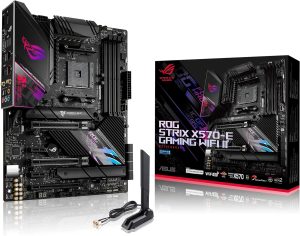
| Specifications | Details |
| Socket | AMD AM4 |
| Processor Compatibility | AMD Ryzen 5000 Series, 5000 G-Series, 4000 G-Series, 3000 Series, 3000 G-Series, 2000 Series, 2000 G-Series desktop processors |
| M.2 Slots | Supports up to two M.2 drives |
| USB Connectivity | USB 3.2 Gen 2, USB 3.2 Gen 2 Type-C |
| Bluetooth | Bluetooth v5.2 |
| Power Solution | 12+4 power stages, ProCool II power connector, alloy chokes, durable capacitors |
| Cooling System | Passive chipset heatsink, VRM heatsink with 8 mm heatpipe, dual M.2 heatsinks, water pump header |
| Networking | 2.5 Gbps LAN, Intel Gigabit Ethernet, WiFi 6E (802.11ax) with MU-MIMO, gateway teaming via GameFirst V |
| Gaming Connectivity | PCIe 4.0, HDMI 2.0, DisplayPort 1.2, dual M.2, USB 3.2 Type-A, USB 3.2 Gen 2 Type-C |
The Optimal Power Solution with 12+4 power stages, ProCool II power connector, and high-quality components make it a reliable choice for handling multi-core processors without breaking a sweat. The Comprehensive Cooling system keeps temperatures in check, thanks to the passive chipset heatsink, VRM heatsink with a heat pipe, and dual M.2 heatsinks.
When it comes to networking, the ASUS ROG Strix X570-E Gaming doesn’t disappoint. With 2.5 Gbps LAN, Intel Gigabit Ethernet, WiFi 6E with MU-MIMO support, and GameFirst V for optimized online gaming, you can stay connected and lag-free during your intense gaming sessions.
The Best Gaming Connectivity aspect is where this motherboard truly shines. Supporting PCIe 4.0, HDMI 2.0, DisplayPort 1.2, and a variety of USB connectors, including USB 3.2 Gen 2 Type-C, you have plenty of options for connecting your gaming peripherals and high-speed storage devices.
Pros:
- Excellent power delivery for high-performance processors
- Robust cooling system for temperature management
- Impressive networking options for lag-free gaming
- Wide range of connectivity options for gaming peripherals
Cons:
- Higher price point compared to some other X570 motherboards
- May have more features than some users need
2. MSI MPG X570 Gaming Plus
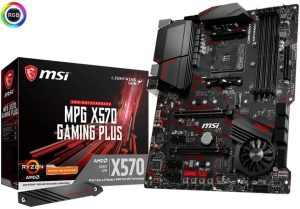
| Specification | Details |
| Processor Support | 2nd and 3rd Gen AMD Ryzen/ Ryzen with Radeon Vega Graphics |
| Memory Support | DDR4 memory, up to 4400+ MHz (OC) |
| Audio Technology | Audio Boost 4 with Nahimic 3 software enhancement |
| Cooling System | Frozr heatsink with patented fan design |
| IO Shielding | Pre-installed and grounded for protection against electrostatic discharge |
One of the standout features of the MSI MPG X570 Gaming Plus is its support for 2nd and 3rd Gen AMD Ryzen processors, making it an ideal choice for gamers and content creators looking for high performance. The DDR4 memory support of up to 4400+ MHz allows for seamless multitasking and smooth gaming experiences.
The Audio Boost 4 technology with Nahimic 3 software enhancement delivers immersive audio quality, enhancing the overall gaming and entertainment experience. The Frozr heatsink with patented fan design ensures efficient cooling, even during intense gaming sessions, thanks to the propeller blade technology and double ball bearings.
The pre-installed IO shielding provides added protection for the motherboard’s IO ports against potential electrostatic discharge damage, ensuring the longevity of the components.
While the MSI MPG X570 Gaming Plus offers impressive features and performance, some users may find the motherboard’s price point on the higher side compared to other models in the market. Additionally, the motherboard’s layout may need to be more user-friendly for beginners who are building their PC for the first time.
Pros:
- Support for 2nd and 3rd Gen AMD Ryzen processors
- DDR4 memory supports up to 4400+ MHz
- Audio Boost 4 technology with Nahimic 3 software enhancement
- Efficient cooling with Frozr heatsink design
- Pre-installed IO shielding for added protection
Cons:
- Higher price point compared to other models
- The layout may not be beginner-friendly
3. Gigabyte X570 Aorus Elite
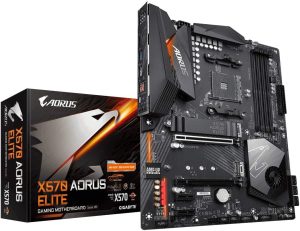
| Specification | Details |
| Processor Support | AMD 3rd Gen Ryzen, 2nd Gen Ryzen, Ryzen with Radeon Vega Graphics |
| Operating System Support | Windows 11 64-bit, Windows 10 64-bit |
| Memory Support | Dual-channel ECC/ non-ECC unbuffered DDR4, 4 DIMMs |
| VRM | True 12 phases digital VRM with extended heatsink |
| Storage Support | Dual ultra-fast NVMe PCIe 4.0/3.0 x4 M.2 with thermal guard |
One of the standout features of the Gigabyte X570 Aorus Elite is its extensive processor support, catering to AMD 3rd Gen Ryzen, 2nd Gen Ryzen, and Ryzen with Radeon Vega Graphics processors. This versatility makes it an excellent choice for users looking to build a powerful and future-proof system.
The motherboard’s support for dual-channel ECC/ non-ECC unbuffered DDR4 memory with 4 DIMM slots ensures enhanced multitasking capabilities and seamless performance. The true 12-phase digital VRM, along with the extended heatsink, provides robust power delivery and efficient thermal management, ideal for overclocking enthusiasts.
The inclusion of dual ultra-fast NVMe PCIe 4.0/3.0 x4 M.2 slots with a thermal guard ensures lightning-fast storage performance while keeping temperatures in check, essential for maintaining system stability during intensive tasks.
While the Gigabyte X570 Aorus Elite excels in performance and features, some users may find the motherboard’s design to be on the bulkier side, potentially posing challenges during installation in compact PC cases. Additionally, the price point of the motherboard may be a determining factor for budget-conscious consumers.
Pros:
- Extensive processor support for AMD Ryzen series
- Dual-channel ECC/ non-ECC DDR4 memory support
- True 12 phases digital VRM with extended heatsink
- Dual ultra-fast NVMe PCIe 4.0/3.0 x4 M.2 slots with thermal guard
Cons:
- Bulky design may pose challenges in small PC cases
- The price point may be higher compared to other models
4. ASRock B550 Phantom Gaming 4
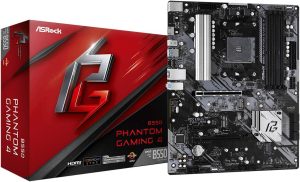
| Specification | Details |
| Memory Support | DDR4 4733+ (OC) |
| Power Phase Design | 8 Power Phase Design, Digi Power |
| Operating System Support | Microsoft Windows 10 64-bit |
| PCIe Slots | 1 PCIe 4.0 x16, 1 PCIe 3.0 x16, 2 PCIe 3.0 x1, 1 M.2 Key E for WiFi |
ASRock B550 Phantom Gaming 4 shines with its robust memory support, allowing for DDR4 4733+ (OC) memory modules. This flexibility in memory compatibility ensures that users can achieve optimal performance and efficiency based on their specific requirements.
The motherboard’s 8 Power Phase Design, coupled with Digi Power technology, delivers reliable power delivery to the system components, promoting stability and enhancing overclocking potential. This feature is particularly appealing to users seeking to push the performance limits of their AMD Ryzen processors.
With a versatile PCIe slot configuration including 1 PCIe 4.0 x16, 1 PCIe 3.0 x16, and 2 PCIe 3.0 x1 slots, users have ample connectivity options for graphics cards, expansion cards, and other peripherals. Additionally, the inclusion of an M.2 Key E slot for WiFi expansion further enhances the motherboard’s connectivity capabilities.
While the ASRock B550 Phantom Gaming 4 offers a range of impressive features, some users may find the absence of support for the Windows 11 64-bit operating system a limitation, especially for those looking to leverage the latest software advancements. Additionally, the lack of dual PCIe 4.0 x16 slots may deter users seeking to run multiple high-end graphics cards in a multi-GPU setup.
Pros:
- DDR4 4733+ (OC) memory support for enhanced performance
- 8 Power Phase Design with Digi Power for reliable power delivery
- Versatile PCIe slot configuration for connectivity options
- M.2 Key E slot for WiFi expansion
Cons:
- Lack of support for Windows 11 64-bit operating system
- Absence of dual PCIe 4.0 x16 slots for multi-GPU setups
5. ASUS TUF Gaming B550M-Plus
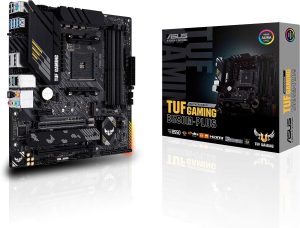
| Specification | Details |
| Socket Compatibility | AMD AM4 Socket |
| PCIe Support | PCIe 4.0 for Zen 3 Ryzen 5000 & 3rd Gen AMD Ryzen CPUs |
| Power Design | 8+2 DrMOS power stages with high-quality alloy chokes and durable capacitors |
| Thermal Solution | Fanless VRM and chipset heatsink, multiple hybrid fan headers, Fan Xpert 4 or UEFI Q-Fan Control utility |
| Networking | 2.5 GB LAN with ASUS LANGuard |
| Gaming Connectivity | HDMI 2.1 (4K@60HZ), DisplayPort 1.2 output, dual M.2 slots (NVMe SSD), USB 3.2 Gen 1, USB 3.2 Gen 2 Type-C & Type-A ports |
The ASUS TUF Gaming B550M-Plus impresses with its robust power design, boasting 8+2 DrMOS power stages equipped with high-quality alloy chokes and durable capacitors. This ensures reliable power delivery, particularly crucial for supporting the latest AMD high-core-count CPUs, such as Zen 3 Ryzen 5000 series and 3rd Gen AMD Ryzen processors.
To address thermal management effectively, the motherboard features a fanless VRM and chipset heatsink, along with multiple hybrid fan headers. Users can further optimize cooling performance through ASUS’ Fan Xpert 4 software or the UEFI Q-Fan Control utility, providing enhanced control over system temperatures.
For high-performance gaming networking, the inclusion of a 2.5 Gb LAN port with ASUS LANGuard protection ensures stable and efficient connectivity, ideal for online gaming and content streaming.
While the ASUS TUF Gaming B550M-Plus excels in many areas, some users may find the absence of built-in Wi-Fi connectivity a drawback, requiring additional hardware for wireless networking capabilities. Additionally, the lack of PCIe 4.0 support for all M.2 slots may limit the full utilization of high-speed NVMe SSDs in certain configurations.
Pros:
- Robust power design for reliable power delivery to high-core-count AMD CPUs
- Effective thermal solution with fanless VRM, heatsink, and fan control options
- High-performance gaming networking with 2.5 Gb LAN and ASUS LANGuard protection
- Comprehensive gaming connectivity including HDMI 2.1, DisplayPort 1.2, and dual M.2 slots
Cons:
- No built-in Wi-Fi connectivity
- Limited PCIe 4.0 support for M.2 slots
Buying Guide: 6 Factors to Consider When Choosing the Best AMD Motherboard
As an expert in the realm of AMD motherboards, I understand the importance of selecting the right motherboard to complement your AMD processor and meet your specific needs. With a multitude of options available in the market, it can be overwhelming to make the best choice. Fear not, as I am here to guide you through the process with six crucial factors to consider before making your purchase decision.
Socket Compatibility:
The first step in selecting the best AMD motherboard is ensuring compatibility with your AMD processor. Different AMD processors require specific socket types, such as AM4 or TR4. Make sure to choose a motherboard that supports your processor’s socket to ensure a proper fit and optimal performance.
Chipset and PCIe Support:
Consider the chipset and PCIe support offered by the motherboard. Opt for a motherboard with the latest chipset that provides features like PCIe 4.0 support for enhanced performance and future-proofing your system. This ensures compatibility with the latest AMD processors and technologies.
Power Design and Thermal Solutions:
Evaluate the power design of the motherboard, including the number of power phases and the quality of components like chokes and capacitors. A robust power delivery system is essential for stable performance, especially when using high-core-count AMD CPUs. Additionally, look for efficient thermal solutions such as heatsinks and fan headers to maintain optimal temperatures during heavy workloads.
Connectivity Options:
Consider the connectivity options offered by the motherboard, including LAN ports, USB ports, audio jacks, and expansion slots. Choose a motherboard that provides ample connectivity options to support your peripherals and devices without the need for additional adapters or expansion cards.
Gaming Features and Networking:
If you are a gaming enthusiast, look for motherboards with gaming-centric features such as high-speed LAN ports, dedicated gaming networking solutions, and support for advanced display technologies like HDMI 2.1 and DisplayPort 1.2. These features enhance your gaming experience and provide smooth connectivity for online gaming sessions.
Budget and Value Proposition:
Lastly, consider your budget and the value proposition offered by the motherboard. While it’s tempting to opt for the most expensive motherboard with all the bells and whistles, prioritize features that align with your needs and budget. Compare prices, features, and user reviews to find a motherboard that offers the best value for your investment.
Recommendations:
Based on the factors outlined above, I recommend considering the ASUS TUF Gaming B550M-Plus from the list provided earlier. With its robust power design, efficient thermal solutions, high-performance gaming networking, and comprehensive connectivity options, the ASUS TUF Gaming B550M-Plus strikes a balance between performance, reliability, and value, making it an excellent choice for gaming enthusiasts and power users alike.
FAQ’S
1. What is the significance of the chipset in an AMD motherboard selection?
The chipset determines the features and capabilities of the motherboard, including PCIe support, connectivity options, and compatibility with AMD processors.
2. How do I know if a motherboard is compatible with my AMD processor?
Check the motherboard’s socket type and ensure it matches the socket type of your AMD processor (e.g., AM4, TR4) for seamless compatibility.
3. Are all AMD motherboards suitable for gaming, or are there specific gaming-oriented models?
While most AMD motherboards can support gaming, certain models offer gaming-centric features like high-speed LAN ports and advanced networking solutions for an enhanced gaming experience.
4. What role does power design play in the performance of an AMD motherboard?
A robust power delivery system with quality components is crucial for stable performance, especially when using high-core-count AMD CPUs that require efficient power management.
5. How do I determine the best AMD motherboard for my budget without compromising on features?
Consider your budget, desired features, and value proposition offered by different motherboards. Compare prices, features, and user reviews to find a motherboard that meets your needs within your budget constraints.
Conclusion
Selecting the best AMD motherboard involves considering multiple factors such as socket compatibility, chipset support, power design, connectivity options, gaming features, and budget constraints. By understanding your specific requirements and prioritizing key features that align with your needs, you can make an informed decision that ensures optimal performance and compatibility with your AMD processor. Whether you are a gaming enthusiast, a content creator, or a power user, choosing the right AMD motherboard is essential for building a reliable and high-performing system that meets your computing demands. Happy motherboard hunting!
